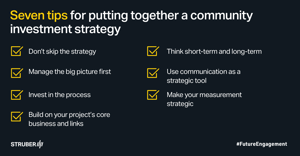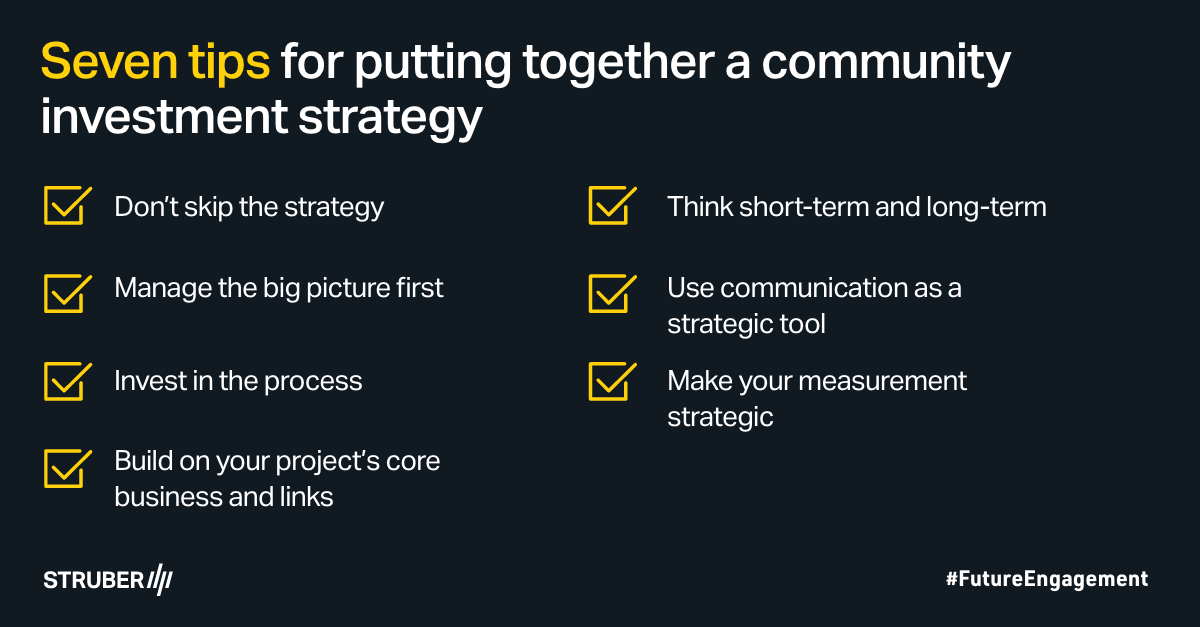
Seven tips for achieving positive community development
26 November, 2020
Community investment is added-value investment, don’t confuse it with a projects obligation to mitigate or compensate local communities for environmental and social impacts caused by the project. These issues need to be addressed separately. Nevertheless, the two are interrelated components of a holistic approach for managing community relationships on a project.
As an engagement specialist, I have heard many well-meaning colleagues talk about the challenges of community investment on their projects. Challenges such as spending project budget on community investment, without relationships in the community improving or sometimes watching the relationship further deteriorate. Or the local community becoming dependant on the project. We are given the endless requests from local groups and organisations. It’s easy to send back the standard response of thanks but no thanks in our rush of project life, but we need to remember that these requests should fit into a much larger strategic approach to the project’s community investment.
Achieving long-term positive community development and impact through project-supported initiatives can be a complex and challenging endeavour. Many programs do not deliver to their full potential and this can be for both the project and the community.

So, what are the principles of a strategic approach to community investment? Projects are beginning to adopt new strategies and ways of engaging with their local stakeholders. Here are seven tips for putting together a community investment strategy:
- Don’t skip the strategy
- Manage the big picture first
- Invest in the process
- Build on your project’s core business and links
- Think short-term and long-term
- Use communication as a strategic tool
- Make your measurement strategic
Don’t skip the strategy
Saying yes to every community request that comes into your Inbox might make you a popular with your local community, BUT it won’t make you strategic. Having a good strategy enables your project to direct Community Investment efforts with purpose. This lowers the risk of unintended outcomes and increases the chances that your community objectives will be achieved.
Manage the big picture first
Community investment is only part of managing your project’s community relationships and it will not succeed if you are not dealing with the fundamental issues or conflicts are unresolved. Your community investment strategy should form part of the following:
- Communication and Stakeholder Engagement Plan
- Environmental Management Plan
- Local Industry Participation Plan
- Your project team should all have ownership of the above plans and therefore of the community investment strategy.
Invest in the process
How a project engages with its local community is just as important as the community investment strategy. The IAP2 Community Engagement Model of Shared Leadership and Action, where communities and organisations participate and contribute to decisions and lead and take responsibility for action towards the outcome collaboration, applies to this process. Getting it right involves focusing less on the number of meetings organised and more on the quality of the interaction. Spend time with your community. Community planning is a means to bring people together to define a collective vision and to work toward a joint vision. By promoting participatory planning, the trust and respect is built from the start on both sides. Ensure you have both formal and informal channels and you integrate all genders and cultures within your community.
Build on your core business
A strategic minded project tends to support community investment programs and activities in areas where it as a business has the most to offer and where there are links to the projects business interests.
Two recent examples of large corporate businesses linking community investment to their core business is Google Earth and Nestle. Google Earth used cutting edge technology to help Amazonian Indians monitor forest destruction. Nestle supported the Philippine government’s “Donate-a-Classroom Program” to help alleviate the critical shortage of classrooms. Under the program the company donated space in its local factories to be used as public school classrooms.
Think Short-term and Long-Term
Finally, any good strategy will have both short-term and long-term objectives. You will have quick high-visibility, “ribbon cutting” strategies that create good-will and gain social licence, these will be short-term investments. Long-term investments that build local capacity over time and support the projects overall goals that target risk management, reputation, productivity or sustainability for example, local skills building or economic growth through local procurement. Finally donations driven by requests from the community, while often can be a short-term strategy and ad-hoc can allow for the project to be seen as responsive to their community and depending on where your community is and their needs can be a vital for your community investment strategy. Never underestimate the value of support for your local festival, sports team or school.
Use communications as a strategic tool
It sounds like a no-brainer. Any community investment strategy would most definitely form part of your communications plan. However, ensuring that stakeholders are informed about your investments and the value they create goes further than a “reactive” photograph opp. presenting an oversized cardboard cheque to extremely enthusiastic school children in the local paper. Having both internal and external communication plans for community investment and implementing these proactively can yield a number of important benefits for positioning the project as socially responsible within the community and boosting the reputation to promoting a collective sense of pride among the team and alleviating the support from project to company wide support and resources. It will also assist with program transparency, reduce the spread of misinformation and build interest from government.
Make your measurement strategic
How do we quantify community investment? This can be challenging when we are protecting the value of the project with intangibles such as trust and goodwill or by decreasing the potential of risk of delays, disruptions, or negative effects on the project’s reputation? Maximising the business value, involves both value creation and value protection and is a new way of measuring community investment. The Struber team are specialised to engage and work with communities on projects that are potentially controversial and high-impact to ensure that community opposition through ongoing efforts to secure and maintain consent from the community can avoid contractual penalties and project delays or can result in the project finishing earlier. Obtaining real-time feedback from your community is also invaluable as a measurement tool and an early warning system for key issues affecting the projects community relationships.
Community investment goes together with a project’s stakeholder engagement efforts.
Experience shows that these types of upfront investments in relationship-building with local communities and partners can position your project to generate positive good-will and build reputation value and pay significant dividends during times of conflict or crisis.